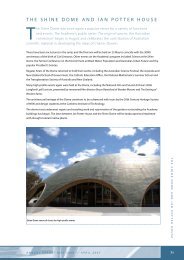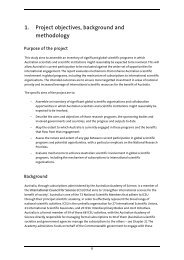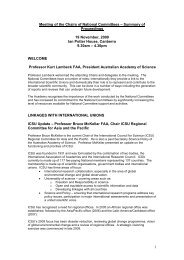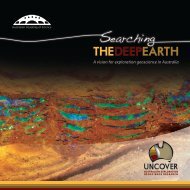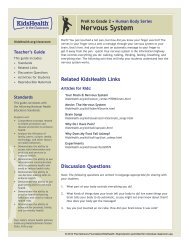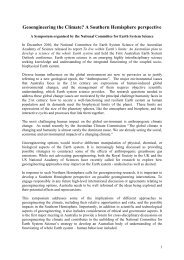Australia's Major National Research Facilities - Australian Academy ...
Australia's Major National Research Facilities - Australian Academy ...
Australia's Major National Research Facilities - Australian Academy ...
You also want an ePaper? Increase the reach of your titles
YUMPU automatically turns print PDFs into web optimized ePapers that Google loves.
The NCBMS performs part of the facilitatory function that the AAS has with respect to participation of <strong>Australian</strong> scientists in the<br />
activities of the respective International Unions.<br />
2. Premises<br />
The most rapidly advancing and most populated areas of Science are those that use the language, techniques, and scientific basis of<br />
Molecular Biology.<br />
Molecular Biology is rapidly moving to a phase where the molecular structures of cell-growth factors, hormones, membrane-bound<br />
receptors, structural proteins, factors that regulate DNA transcription etc are no longer the end point of scientific enquiries. Rather,<br />
areas of study such as Structural Genomics, Bioinformatics, and Systems Biology have led to a much more comprehensive description<br />
of the molecular basis of biological systems than the previous less-integrated disciplines.<br />
All these new groupings, and the parent disciplines, now make extensive use of sophisticated equipment often based on massively<br />
parallel analytical throughput. The equipment is typically linked to state-of-the-art computers, robotics, and advanced electronics; and<br />
in some cases it is the biological research that, significantly, provides impetus for great advances in the ‘enabling’ Physics and<br />
Engineering. Particular, notable examples of these are given below.<br />
3. Caveat<br />
When writing a submission on behalf of such a huge cross-section of <strong>Australian</strong> scientists, as is embraced by the NCBMS, it is very<br />
difficult to give an account that is perceived to be truly balanced. On the other hand the recording of our opinions ensures that our<br />
ideas are not lost from the discussions. It is expected that there will be many submissions to the present enquiry and that these will add<br />
to and, we hope, complement the present one. Thus at the risk of being accused of being biased, we respond by saying that the<br />
comments are from a position of experience in the respective areas. Accordingly, we present the following:<br />
4. Areas of Science using particularly expensive infrastructure<br />
4.1. Metabolomics/Metabonomics<br />
This is an emerging post-genomic tool for understanding nutrition and the metabolic basis of disease and drug action. The postgenomic<br />
era has been greatly enhanced by technologies that allow the function of cells and even whole organisms to be explored at the<br />
molecular level. This work entails the measurement of global sets of low-molecular-weight metabolites. Profiles of metabolites in<br />
body fluids or tissues can be regarded as important indicators of normal or disease states. These profiles provide a comprehensive view<br />
of cellular control mechanisms in humans and animals, and raise the possibility of identifying correlative markers of disease.<br />
Metabolomic research uses analytical techniques such as nuclear magnetic resonance (NMR) spectroscopy and mass spectrometry<br />
(MS) to measure sets of low-molecular-weight metabolites in biological samples. Advanced statistical and bioinformatics tools are<br />
then used to maximize the extraction of information and interpret the large datasets that are produced. It has already been used in<br />
studies of toxicological mechanisms and inborn errors of metabolism. It offers a means of investigating the complex relationship<br />
between nutrition and metabolism, specific examples include: the metabolism of dietary substrates, drug-induced disturbances of lipid<br />
metabolites in diabetes mellitus and the therapeutic effects of vitamin supplementation on chronic metabolic disorders.<br />
18





